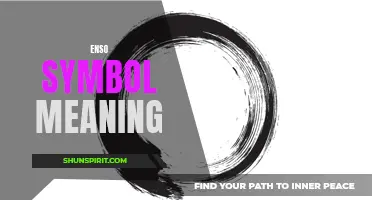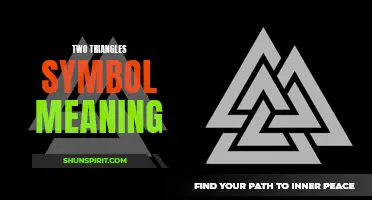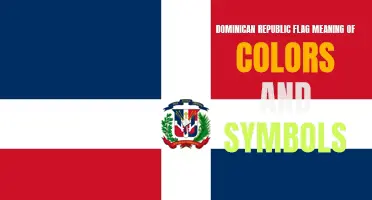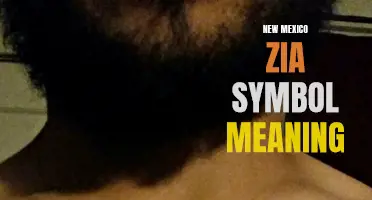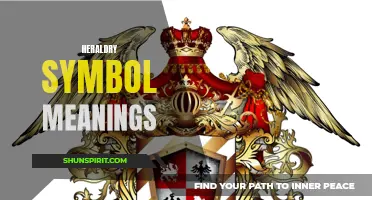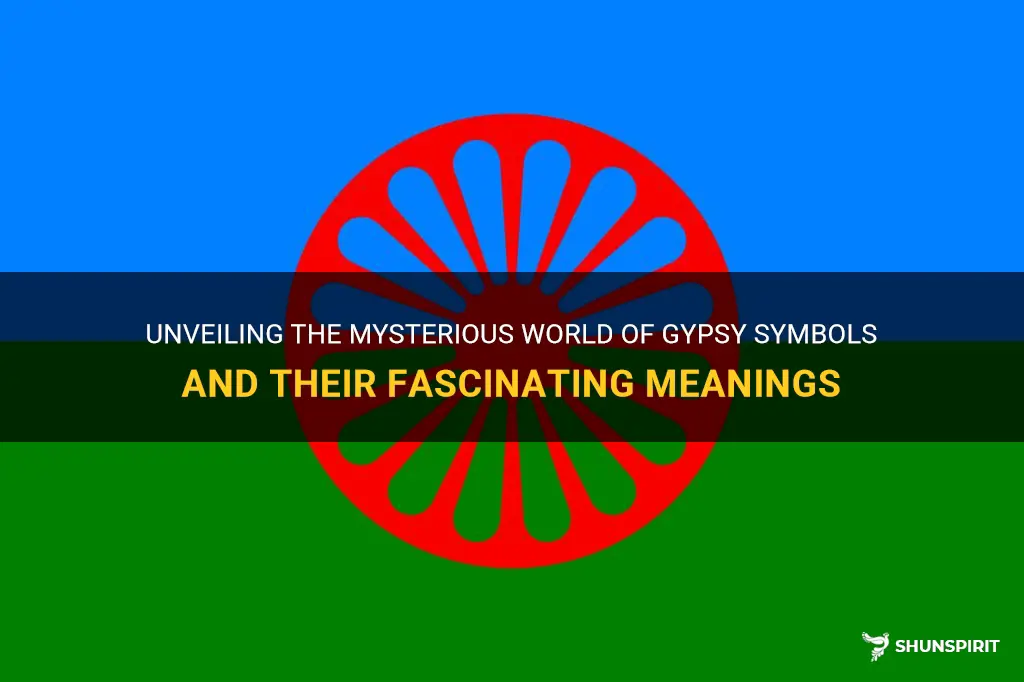
Gypsy symbols have been shrouded in mystery and enchantment for centuries, captivating the imagination and evoking a sense of wanderlust. These rich and intricate symbols hold hidden meanings and deep cultural significance within the Romani community. From the vibrant and ancient Tarot cards to the symbolic language of their personal tattoos, each symbol tells a story and offers glimpses into the nomadic lifestyle and the resilience of a culture that has flourished despite the challenges it has faced. Unravel the veil of mystique and embark on a journey to uncover the fascinating world of gypsy symbols and their profound meanings.
What You'll Learn
- What are some common symbols associated with gypsy culture and what do they represent?
- How has the meaning of gypsy symbols evolved and been interpreted over time?
- Are there specific symbols that are considered sacred or taboo within the gypsy community?
- Can you provide examples of gypsy symbols used in art, jewelry, or tattoos?
- Are there any resources or books that delve deeper into the meanings and symbolism of gypsy culture?

What are some common symbols associated with gypsy culture and what do they represent?
Gypsy culture, also known as Romani culture, is a rich and vibrant tradition that spans across many countries and regions. One of the most fascinating aspects of this culture is the use of symbols, which hold deep meaning and significance. These symbols often serve as a way to express identity, beliefs, and values. In this article, we will explore some common symbols associated with gypsy culture and delve into their meanings.
- The Wheel: The wheel is one of the most common symbols in gypsy culture and represents life's journey, cyclical nature, and the constant change and movement in one's life. It also symbolizes progress, luck, and fortune.
- The Star: The star is a powerful symbol that signifies hope, guidance, and enlightenment. It represents the deep connection between the earthly and divine realms. In gypsy culture, it is believed that stars have the power to guide and protect individuals.
- The Moon: The moon is a symbol of femininity, intuition, and the subconscious mind. It represents the mystical and spiritual aspects of life and reflects the gypsy culture's deep connection with nature and the cycles of the moon.
- The Hand: The hand, particularly the open palm, is a symbol of protection, blessings, and good luck. It is often used to ward off evil spirits and negative energy. In gypsy culture, it is believed that the open hand can bring good fortune and protect against the evil eye.
- The Romani Flag: The Romani flag is a significant symbol for the Romani people. It consists of two horizontally divided fields: blue on top and green at the bottom. The blue represents heaven and the spiritual realm, while green symbolizes the earthly realm and the connection to nature. It is a powerful representation of Romani identity and solidarity.
- The Horse: The horse is a symbol of freedom, strength, and power. It represents the nomadic lifestyle of the gypsy culture and the ability to adapt to changing circumstances. Horses are highly valued in Romani culture and play a significant role in various traditions and rituals.
- The Flower: Flowers, especially roses, hold a special place in gypsy culture. They symbolize beauty, love, and passion. Roses are often used in celebrations and ceremonies, and their presence signifies happiness, abundance, and fertility.
- The Sun: The sun is a symbol of life, vitality, and energy. It represents optimism, success, and the ability to overcome challenges. In gypsy culture, the sun is associated with blessings and abundance and is considered a source of divine power.
These symbols are just a glimpse into the rich symbolism that permeates gypsy culture. Each symbol carries its own unique meaning and significance, and they are often used in various art forms such as jewelry, clothing, and tattoos. They beautifully reflect the deep spirituality, resilience, and sense of belonging that is central to gypsy culture.
Unraveling the Mysteries of Hawaiian Petroglyphs: Symbols and Their Profound Meanings
You may want to see also

How has the meaning of gypsy symbols evolved and been interpreted over time?
Gypsy symbols have a long history and have evolved and been interpreted in various ways over time. These symbols hold deep meanings and are still revered and used by the Romani people today. They not only represent their cultural heritage but also hold significance in their daily lives.
The Romani people, also known as Gypsies, have a rich cultural history that dates back centuries. They are a nomadic group that has migrated across various regions, and their symbols have been influenced by the diverse cultures they have encountered along the way.
One of the most well-known and widely recognized symbols in Romani culture is the Romani wheel. This symbol represents the journey of life and the eternal cycle of birth, death, and rebirth. It is often depicted as a wheel with eight spokes, which symbolize the eight forms of life in Romani mythology. The Romani wheel is seen as a powerful symbol of protection and is believed to bring good luck.
Another significant symbol in Romani culture is the hand of Fatima, also known as the hamsa. This symbol is believed to ward off evil eyes and protect against negative energies. It is often depicted as a hand with an eye in the center and is used as a talisman to bring good luck and fortune. The hand of Fatima is also associated with fertility and is often worn as a pendant or displayed in homes and businesses.
The Romani flag is yet another symbol that holds great meaning for the Romani people. It features a blue wheel with 16 spokes on a green and blue background. The blue wheel represents the Romani journey and the green and blue represent nature and freedom. The flag is a symbol of pride and solidarity among the Romani people and is often displayed at cultural events and gatherings.
Over time, the interpretation and use of these symbols have evolved. In the past, gypsy symbols were often used clandestinely as a way for Romani people to communicate and identify each other. They provided a sense of belonging and unity in a society that was often hostile towards them.
Today, these symbols are more openly embraced and recognized by both the Romani community and the broader society. They serve as a reminder of the Romani cultural heritage and are often used as a way to celebrate and showcase their identity. Many Romani people proudly wear jewelry adorned with these symbols or display them in their homes.
It's important to note that the meaning and interpretation of gypsy symbols may vary among different individuals and communities. While some may view them as purely cultural and symbolic, others may attribute magical or spiritual powers to them. The significance and understanding of these symbols often depend on personal beliefs and experiences.
In conclusion, the meaning of gypsy symbols has evolved over time, but their significance and power have remained intact. They serve as a connection to the rich cultural heritage of the Romani people and are treasured symbols of identity and protection. Whether used as a form of communication, a talisman, or a source of pride, these symbols continue to be revered and respected by the Romani community and those who appreciate their beauty and meaning.
Understanding Navionics Chart Symbols and Meanings
You may want to see also

Are there specific symbols that are considered sacred or taboo within the gypsy community?
Within the gypsy community, there are indeed specific symbols that are regarded as sacred or taboo. These symbols hold deep meanings and are often used in various aspects of gypsy culture, such as rituals, fortune-telling, and traditional beliefs. Let's explore some of these symbols and their significance.
- Hamsa Hand: The Hamsa Hand, also known as the Hand of Fatima, is considered a symbol of protection against the evil eye. It is believed to bring good fortune, health, and happiness. The Hamsa Hand is often displayed in gypsy homes and worn as jewelry to ward off negative energy.
- Wheel of Fortune: The Wheel of Fortune is a powerful symbol commonly associated with gypsy culture and is often used in divination practices. It represents the cyclical nature of life, the constant ups and downs, and the changes that occur. The Wheel of Fortune is believed to bring luck and fortune to those who understand and honor its message.
- Pentagram: The pentagram is a five-pointed star often associated with spirituality and protection. For gypsies, the pentagram holds a sacred meaning and represents the five elements: earth, air, fire, water, and spirit. It is sometimes used in rituals and ceremonies to invoke the power of these elements.
- Evil Eye: The evil eye is a widely recognized symbol across many cultures, including the gypsy community. It represents protection against harmful intentions and negative energy. The gypsies believe that wearing an evil eye pendant or displaying the symbol in their homes will ward off the evil eye and bring good luck.
While these symbols are considered sacred within the gypsy community, there are also symbols that are viewed as taboo or unlucky. It is believed that certain symbols can attract negative energy or bring bad luck. Some examples of such taboo symbols include:
- Skull and Crossbones: The skull and crossbones symbolize death and danger, and its presence is often associated with negative connotations. In the gypsy culture, this symbol is regarded as unlucky and may bring harm or misfortune.
- Broken Mirror: Breaking a mirror is considered bad luck in many cultures, including among gypsies. It is believed to bring seven years of bad luck or misfortune. Therefore, the broken mirror symbol is considered taboo and is avoided.
- Upside-down Cross: The upside-down cross, also known as the inverted cross, is often associated with anti-religious or satanic symbolism. In the gypsy community, this symbol is viewed as taboo and may be interpreted as a sign of disrespect towards religious beliefs.
- Black Cat: While black cats are often seen as symbols of luck or protection in some cultures, in the gypsy community, they are often associated with bad luck or witchcraft. Crossing paths with a black cat is believed to bring misfortune and bad omens.
It is important to note that beliefs and interpretations of symbols can vary among different gypsy communities and individuals. Not all gypsies may regard the same symbols as sacred or taboo, as beliefs and practices can vary greatly. The meanings and usage of these symbols should be understood within their specific cultural context.
Understanding the Meaning Behind Dehumidifier Symbols: A Handy Guide
You may want to see also

Can you provide examples of gypsy symbols used in art, jewelry, or tattoos?
Gypsy symbols have a rich history and are often associated with spiritualism, traditions, and mystical beliefs. These symbols have found their way into various art forms, including jewelry, tattoos, and other forms of adornment. Here are some examples of gypsy symbols used in art, jewelry, and tattoos.
- Wheel of Fortune: The Wheel of Fortune is a popular gypsy symbol representing fate and destiny. It symbolizes the cyclical nature of life and the constant changes one encounters. This symbol is often incorporated into intricate tattoo designs and can be seen on jewelry, such as pendants and rings.
- Horseshoe: The horseshoe symbol is believed to bring good luck and ward off evil spirits. In gypsy culture, it is seen as a protective talisman. Horseshoe symbols are frequently used in art, particularly in black and white ink tattoos, as well as charm bracelets and earrings.
- Moon: The moon holds a special significance in gypsy culture, representing intuition, femininity, and the ebb and flow of life. Crescent moon symbols are a popular choice for tattoos, often accompanied by other elements like stars and flowers. They can also be seen in jewelry designs, such as pendants and earrings.
- Tarot Cards: Tarot cards have a long-standing association with gypsy culture and are often used as symbols in art and jewelry. Each card carries meaning and symbolism in gypsy traditions. Artists incorporate these cards into tattoo designs or create jewelry pieces featuring individual cards or a combination of multiple cards set in pendants, rings, or bracelets.
- Eye: The eye symbol, also known as the Evil Eye, is believed to protect against negative energy and bring good luck. This symbol is prominent in gypsy culture and art. It is often used in tattoo designs, especially in conjunction with other symbols like feathers or arrows. Eye symbols can also be found in jewelry, such as necklaces, bracelets, and rings.
- Romani Flag: The Romani flag, consisting of a blue and green background with a red wheel in the center, is a widely recognized symbol of the Romani people. This flag represents the Romani's rich culture and heritage. This symbol can be incorporated into art pieces, particularly in the form of paintings, as well as in jewelry designs.
- Roses: Roses are frequently used in gypsy-inspired art, jewelry, and tattoos. They symbolize beauty, love, and passion. Often depicted as a single rose or part of a larger design, roses are a classic choice for gypsy-inspired body art. They can also be seen in jewelry designs, such as earrings, pendants, and rings.
Gypsy symbols have transcended their original cultural context and have become popular among people from different backgrounds who appreciate their beauty and the meanings they carry. Whether as tattoos, jewelry, or art, these symbols continue to evoke a sense of mystery, spirituality, and wanderlust.
The Intriguing Symbolism and Significance of the Tomoe Symbol
You may want to see also

Are there any resources or books that delve deeper into the meanings and symbolism of gypsy culture?
Gypsy culture is known for its rich history, deep sense of community, and vibrant traditions. For those who are interested in learning more about the meanings and symbolism behind gypsy culture, there are several resources and books available that delve deeper into these fascinating aspects.
One highly recommended resource is the book "Gypsy Folk Tales" by Diane Tong. This collection of traditional stories and legends offers a unique insight into the beliefs, values, and symbolism of the gypsy community. Through these tales, readers can gain a deeper understanding of the cultural significance of various symbols and motifs.
Another valuable resource is "The Gypsy Language" by Angelo Rzadziński. This book explores the Romani language, which is spoken by many gypsies around the world. By learning about the language used by the community, readers can uncover hidden meanings and symbolism embedded in everyday conversations and expressions.
For a more historical perspective, "Bury Me Standing: The Gypsies and Their Journey" by Isabel Fonseca is a highly recommended read. This book delves into the history, traditions, and struggles of the gypsy community across different countries and time periods. By understanding the historical context, readers can better appreciate the meanings and symbolism that have been passed down through generations.
In addition to these books, there are also online resources and academic publications that explore the meanings and symbolism of gypsy culture. Websites such as the Gypsy Lore Society and academic journals like the Journal of the Gypsy Lore Society provide in-depth analyses and studies on various aspects of gypsy culture, including symbolism.
When delving into the meanings and symbolism of gypsy culture, it is important to approach the subject with cultural sensitivity and respect. Gypsy culture is diverse and extends across multiple countries and communities, so it is essential to avoid generalizations and stereotypes. Instead, it is recommended to seek out authentic sources written by members of the gypsy community or scholars with a deep understanding of the culture.
By exploring these resources and books, readers can gain a deeper appreciation for the meanings and symbolism within gypsy culture. Whether it's through traditional stories, language, or historical accounts, these resources offer valuable insights into the rich tapestry of gypsy traditions and beliefs.
Unraveling the Mystery: Exploring the Symbols and Meanings of Pysanky Eggs
You may want to see also
Frequently asked questions
Answer 1: The horse is a powerful symbol in gypsy culture and represents freedom, travel, and strength. It is often associated with the idea of following one's own path and not being tied down to one place or way of life.
Question 2: What does the gypsy symbol of the moon represent?
Answer 2: The moon is another important symbol in gypsy culture and represents femininity, intuition, and the cycles of life. It is often associated with the idea of intuition and following your instincts, as well as the ever-changing nature of existence.
Question 3: What is the significance of the gypsy symbol of the key?
Answer 3: The key is a symbol of unlocking potential and opening new doors. In gypsy culture, it represents the ability to find solutions and overcome obstacles. It is often seen as a symbol of power and opportunity.
Question 4: What does the gypsy symbol of the rose mean?
Answer 4: The rose is a symbol of love, beauty, and passion. In gypsy culture, it represents the intense emotions and desires that drive us. It can also symbolize the idea of balance and harmony between the physical and spiritual realms.
Question 5: What is the meaning of the gypsy symbol of the wheel?
Answer 5: The wheel is a symbol of cycles and change. In gypsy culture, it represents the ever-turning nature of life and the idea that everything is constantly in motion. It can also symbolize the idea of fate and the interconnectedness of all things.


